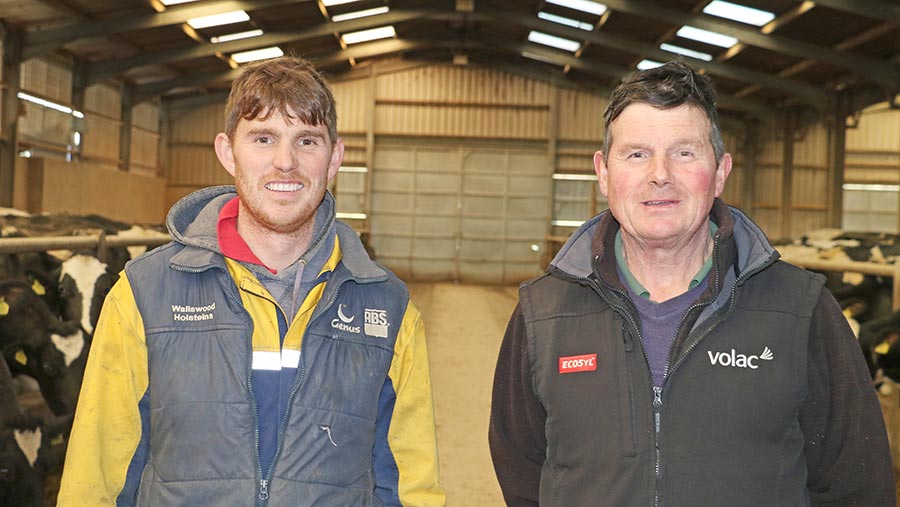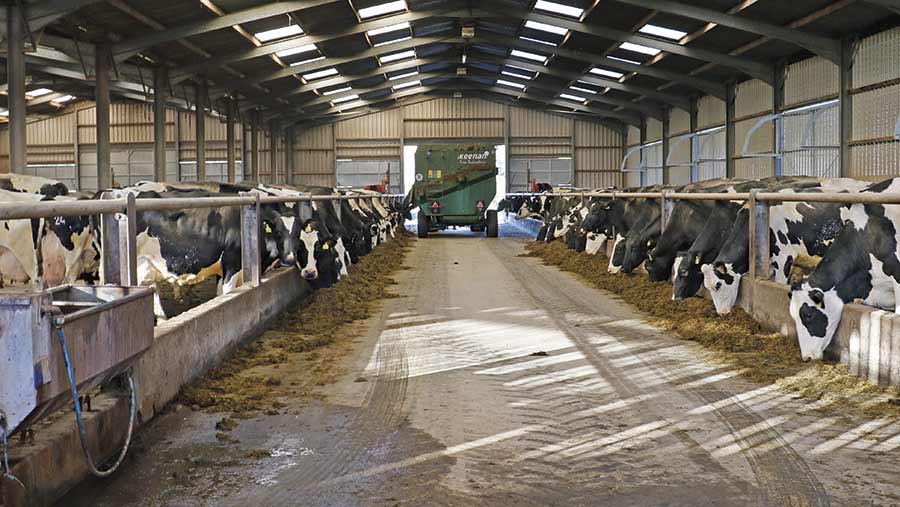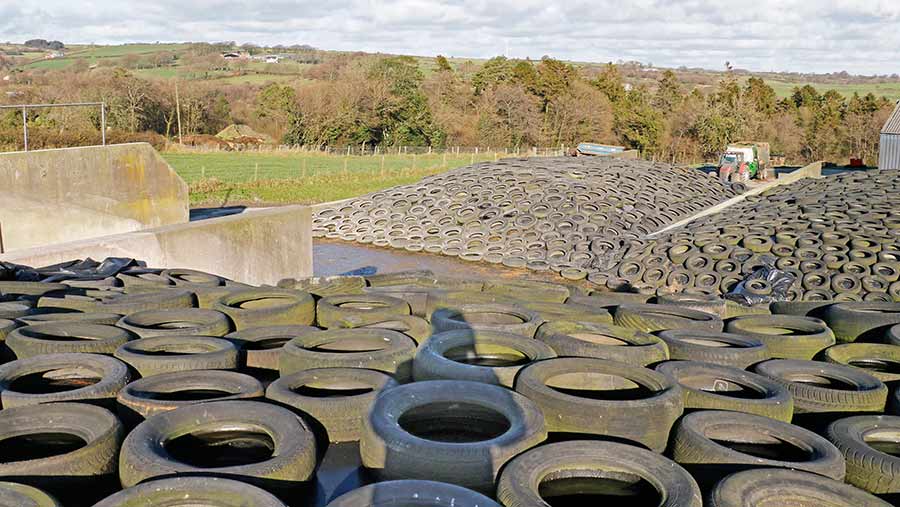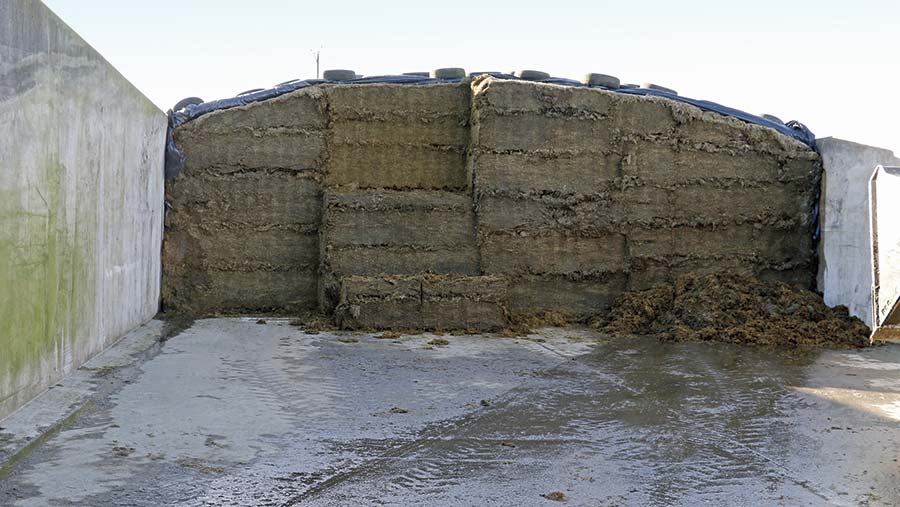How dairy farmers are making four cuts of 11.3ME silage
Although the Williams family live in one of the wettest areas of Wales, with an annual rainfall of 1,300mm, it isn’t preventing them from them from making top-quality grass silage.
This year’s four cuts have averaged 11.3ME, with protein hitting more than 15%.
The heavy land and high rainfall at Clyncoch Farm, Cwrtnewydd, forced the family to fully house their 165-cow pedigree Holstein Waliswood herd six years ago.
See also: Benefits of switching to a multicut silage system
Ground was being poached heavily by cows when they were turned out during the day in the spring and summer months, recalls owner Paul Williams, who farms in partnership with his wife Bessie and son Bryn.
A dairy shed was built to accommodate the move, comprising four rows of sawdust-bedded cubicles divided by two central feed barriers and an adjoining herringbone parlour.

Bryn Williams (left) with his father Paul © Rhian Price
The aim was to keep milk supply at a level profile year-round; avoiding the dip in milk when cows were turned out to grass, explains Paul.
Forage management
A big focus is being placed on grassland and forage management and feeding to ensure cows are producing consistent yields of 32-35 litres/day sold.
On average, four cuts are taken annually. The first cut is taken in May, with subsequent cutting carried out every six weeks thereafter.
To improve ration consistency the family get their forage analysed and balance the ration by feeding two cuts at once (see ‘2017 silage analysis results’, below).
Cows are fed a single group total mixed ration (TMR) (see ‘TMR’, below) twice daily to avoid feed going off, with a Lely robot pushing up feed hourly and cows given 1m of feed space a head.
They are also fed cake to yield in the parlour up to a maximum of 4kg/day in early and mid-lactation.

Cows are fed two times a day © Rhian Price
Combining cuts
Currently, third cut is being fed alongside second to better balance the ration.
“Second cut is higher in dry matter and fibre due to the weather delaying cutting in June and third cut is lower in dry matter and fibre, but higher in ME and protein,” explains the farm’s independent nutritionist Hefin Richards of Rumenation.
“If we were only feeding second [cut] we would struggle to get milk whereas all of first would be a big challenge because it’s low in fibre and high in protein,” he adds.

There are four clamps, one for each silage cut © Rhian Price
It’s estimated at current intake levels the two silages combined will last until April, when they will then start mixing fourth cut with second.
A big bonus to this system is ration consistency is much improved, believes Mr Richards.
“You only end up changing half the forage at once and it lasts twice as long before you have to switch,” he explains.
Clamp management is meticulous (see ‘The silage-making process and clamp management’, below) and to date Paul says following these steps has meant they haven’t had any pit wastage.

Silage is analysed on farm © Rhian Price
Future
Next spring, Bryn and Paul may take five cuts, depending on the season, by reducing cutting intervals by one week to every five weeks opposed to six.
“People were talking about cutting every six weeks 20-30 years ago, but we are growing much better grass now and first cut is generally ready by the first week of April,” explains Mr Richards.
Rainfall averages
- Last year, the Met Office revealed the wettest places in Wales, where the highest rain feel was Capel Curig, Conwy, at 2,799.2mm
- According to the list, Cwrtnewydd would have ranked eighth place alongside Bala, Gwynedd
Farm facts
- Milk sold to Meadow Foods
- Milking 165 cows twice daily; total 340 head including youngstock
- Producing 11,066 litres per cow a year at 4.04% butterfat and 3.26% protein
- Somatic cell counts running at 81 and Bactoscan at 14
- 2,700 litres of milk produced from forage
- New shed is fitted with slats and underground slurry storage
- 67ha in total
- Calving at two and selling surplus heifers at Carmarthen Market
- Winners of Holstein UK All Wales Holstein herd and Master Breeder 2017
The silage-making process and clamp management

Clamp management is meticulous © Rhian Price
- Weeds are spot sprayed in the spring using a quad bike and flotation tyres.
- 32ha sprayed by the contractor.
- The first cut is taken in May and every six weeks thereafter.
- Grass is cut and left six hours before tedding.
- It is then wilted for a maximum of 24 hours before being raked and chopped with a self-propelled forager.
- 70kg/ha of 28% nitrogen fertiliser is applied to grass in the spring and after each cut.
- Slurry is applied in between cuts (the day after silage) at 4,942g/ha using umbilical tankers
- Ecosyl additive applied before being clamped.
- Each cut is ensiled separately in four concrete silage clamps. Two tractors roll the clamp to achieve adequate compaction.
- The clamp is sheeted in the same day. Double sheeting is used to reduce aerobic spoilage. The first sheet is pulled over the pit. Side sheets are then folder over the top of this before a second top sheet is added, with tyres covering the whole clamp within touching distance.
- Silage is removed using a shear grab to keep the pit face even and clean.
2017 silage analysis |
||||
|
|
First |
Second |
Third |
Fourth |
|
DM |
39.5 |
34.2 |
25.4 |
28 |
|
ME |
12.1 |
10.85 |
11.32 |
11 |
|
Protein |
16.48 |
13.61 |
16.04 |
16.37 |
|
Sugars |
5.6 |
4.25 |
2.52 |
3.1 |
|
Neutral detergent fiber |
38.6 |
48.1 |
42.1 |
46 |
|
Total mixed ration |
||
|
Ingredients |
Kg/head |
Kg DM a head |
|
Grass silage (third cut) |
27 |
7.25 |
|
Grass silage (second cut) |
14 |
4.80 |
|
Megalac |
0.25 |
0.25 |
|
Minerals |
0.10 |
0.10 |
|
Acid buff |
0.08 |
0.08 |
|
SC Toxisorb 25g |
0.02 |
0.02 |
|
Premix/blend |
9.50 |
8.26 |
|
Total |
50.96 |
20.80 |
